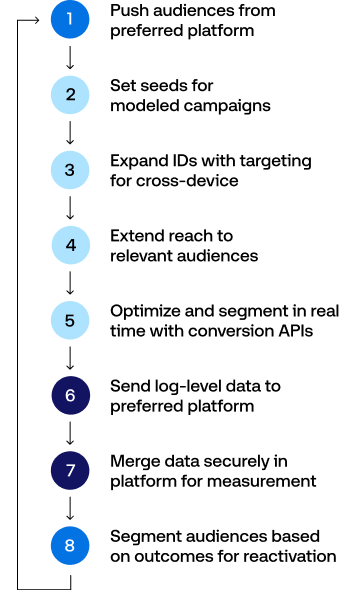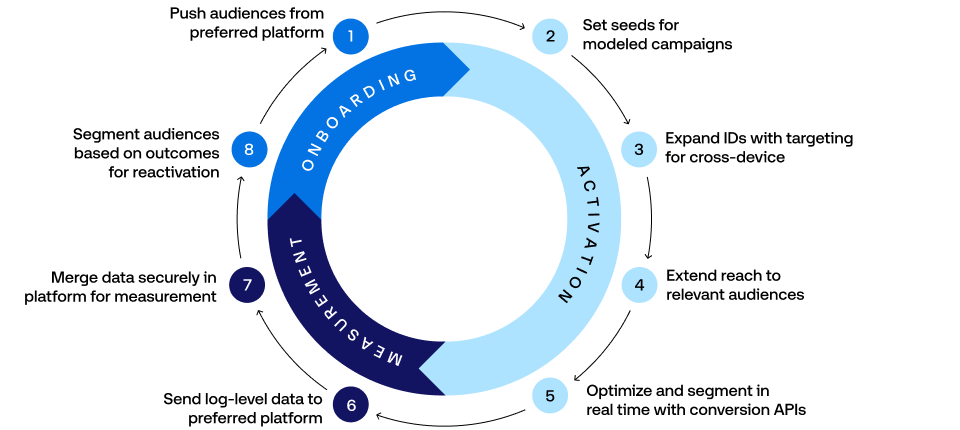Resources Data and measurement
The premium internet: where brands can reach audiences and activate first-party data

Select your country or region to see content tailored to your country.
Recruiting fraud is a growing issue for many companies.
The Trade Desk takes this issue seriously and is taking steps to address it.
Identity
Advertisers’ first-party data is often spread across dozens of systems: customer data platforms (CDPs), data management platforms, data warehouses, and clean rooms, to name a few. As a result, it can be dizzying to figure out how to bring all that data together and maximize its value to drive advertising ROI. Additionally, how do you know which data is important, and when do you have enough to make an impact?

The Trade Desk has a solution for this challenge: Galileo, a comprehensive customer data solution that enables advertisers to seamlessly onboard, activate, and scale their first-party audiences across the open internet — all within our platform.
See how Galileo can help maximize the value of your first-party data in Kokai:
All good marketing starts with the data you know about your best customers. That data is your most valuable asset, as it can help you reach your customers where they are, create better modeled audiences, segment more effectively, and enrich your data over time. By enabling these processes, Galileo can help you foster more effective relationships with customers.
While the amount may differ depending on the brand, all marketers have access to some first-party data. The good news? In Kokai, a little goes a long way. Whether you only have access to site- and app-visit data or you have extensive data around conversions and customer lifetime value, you can put it to use in our platform.
Galileo allows advertisers to onboard their first-party data from a wide range of sources, including clean rooms, CDPs, and cloud storage providers. We support some of the largest and most popular data partners, such as Adobe, Hightouch, Salesforce, and Amazon Web Services (AWS). Once the data is imported, you can instantly begin matching to audiences using your deterministic IDs of choice (such as Unified ID 2.0). Unlike siloed identity solutions that function like mini walled gardens, Galileo lets you match identities across publishers, platforms, devices, and channels, making it possible to control for reach and frequency across the entire open web.
It is a common misconception that advertisers need vast amounts of first-party data, or a particular kind of data, to make good use of it in a demand-side platform. No matter how much or what kind of data you have, Galileo can help you get the most out of it in Kokai. You just need to bring the data and set your desired outcomes for a given campaign. Kokai’s AI tools will take cues from you to help you craft audience seeds, optimize reach and frequency, and serve as your consultant along the way.
When you activate your first-party data in Kokai, you are beginning a process that can improve the usefulness of your data over time.


Kokai facilitates a cyclical process that maximizes the return on investment that your first-party data can deliver. First, it allows you to capitalize on all traditional IDs (such as cookies, mobile ad IDs, and device IDs) and alternative IDs (such as RampIDs and UID2s) for omnichannel coverage and scaled direct inventory targeting. Then, you can use your best data for targeting existing users and modeling new audiences from your high-value customers.
Finally, you can unify measurement workflows by sending log-level data to external environments and connecting data to retail, measurement, and audience partners. As your campaigns bring in more data, it gets reactivated in the platform to help improve your targeting and identity resolution.
Ready to start getting the most out of your first-party data in Kokai? Contact your representative at The Trade Desk to learn more about all the data solutions at your fingertips today.
Resources Data and measurement

Resources Identity

Resources Identity
